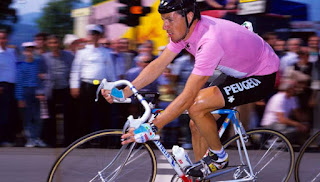 |
| Photo by Zac Williams |
I forget what we were discussing. But I remember what a student said: “My father always talks about walking barefoot three miles in the snow every day to go to school.”
A pause. “He was in Jamaica!” She wasn’t talking about the neighborhood in Queens.
There’s always some member of the older generation (as if I can talk about them in the third person!) who insists that they had to be smarter, braver and tougher in the good ol’ days. Such a person laments how the “younger generation” had “gone soft.”
That criticism has been leveled at the peloton in the just-ended 2023 Giro d’Italia.
What are the bases for such an assessment?
One is that of 176 riders who started, 125 finished. That is indeed a higher rate of attrition than befalls most races, whether the local Category Four criterium or a Grand Tour like the Giro. But the riders who started three weeks ago included current and former champions, and the “quitters,” as they were called, included the rider who was wearing the race leader’s maglia rosa.
So what, exactly, caused 51 riders to—if you are to believe the critics—melt like a cake in the worst song in the history of pop music. (I can forgive Donna Summer for her disco stuff, but not for giving new life to that song!)
Well, for one thing, there was the weather which, even the haters would concede, was some of the worst in Giro history. The rain, sleet and all of the other meteorological delights caused crashes that took out a number of riders, including 2020 winner Tao Geoghegan Hart.
Then there was something that’s sneaking up on much of the rest of the world: a rebound COVID-19. When Belgian Remco Evenepoel, a favorite to win and Aleksandr Vladivostok, a strong contender for a podium spot, were forced to withdraw because of positive tests, they were accused of “faking” or being unable or unwilling to suffer.
As Ryan Mallon points out, cycling differs from other sports in that there is little incentive for a rider to “fake”or “dive.” Players can get themselves or their teams free kicks, foul shots or power plays by rolling on the pitch, court or rink to exaggerate the effect of an opponent’s hit. On the other hand, if riders crash, fall or are otherwise interrupted, they are rewarded with a longer, tougher chase to keep up—if indeed they still can—with the rest of the pack.
If there is an irony in everything I’ve just mentioned, here it is: Some of those who are saying that the riders who had to leave the Giro were “faking” or had “gone soft” are professionals who raced during the ‘90’s and early 2000s. You know: the era of PDM, Festina, Lance, Marco Pantani and a few others who, as Jacques Anquetil would say, didn’t win races on salad and mineral water.
Maybe they have a right to call today’s riders “soft”: After all, those old heroes had to have really high pain thresholds to withstand all of those needles!













